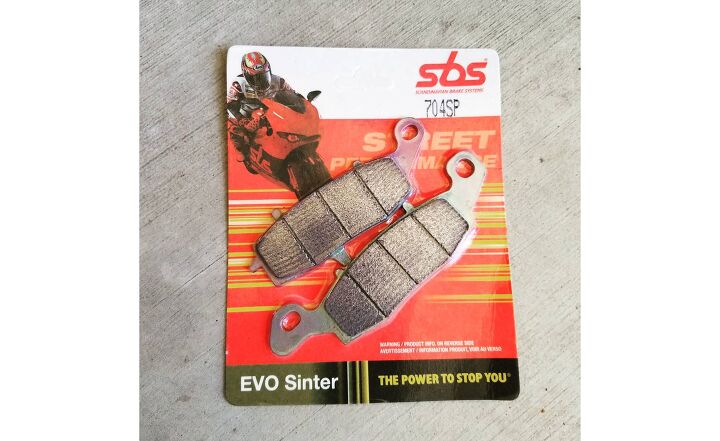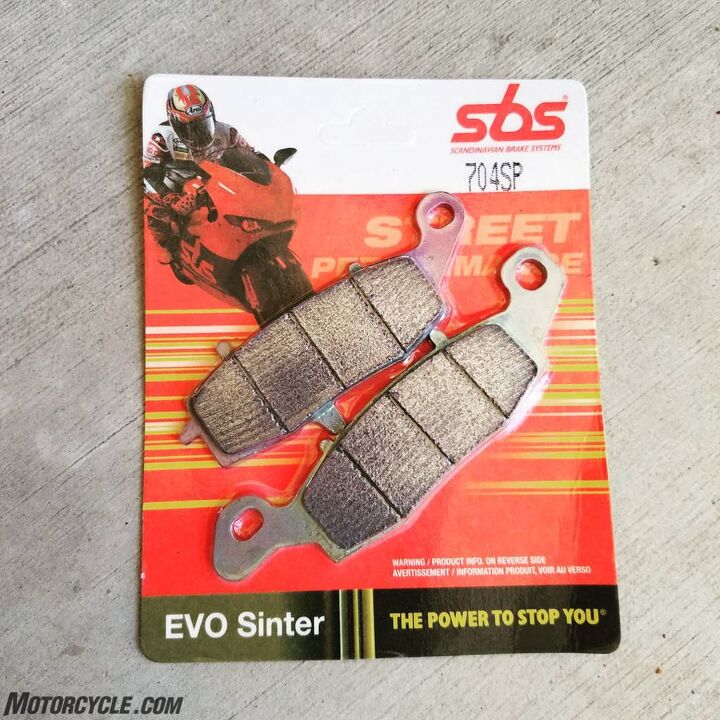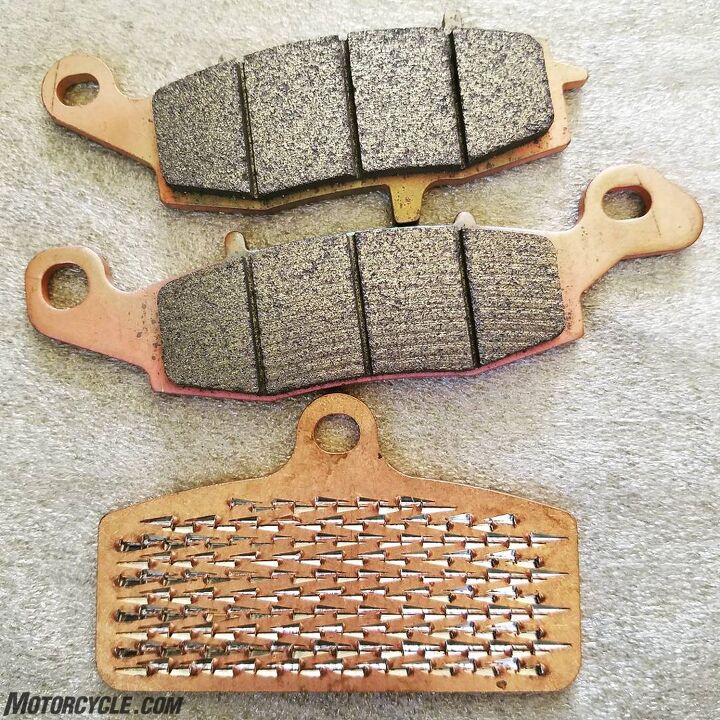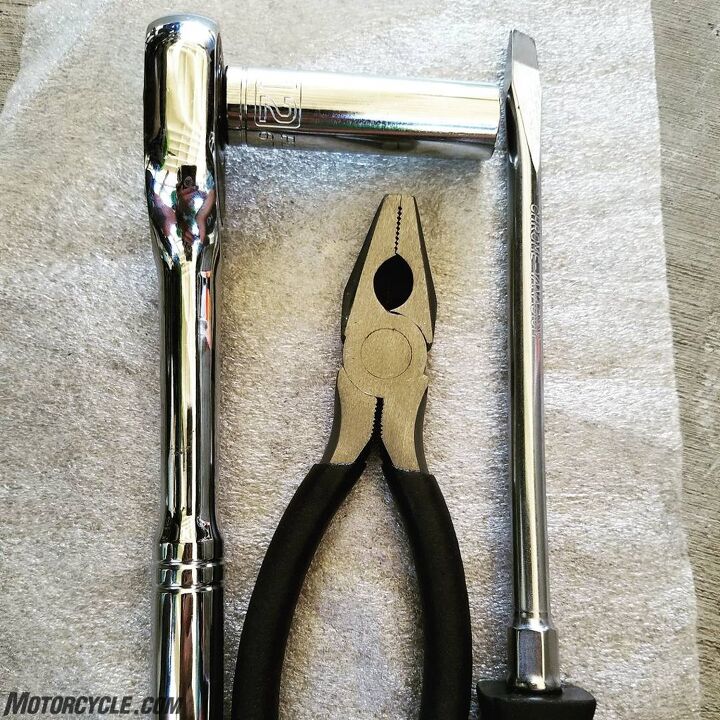
 |
|
|
#1 |
|
All the news that's fit to excerpt
Name: newsie
Location: who knows?
Join Date: Jun 2008 Motorcycle(s): only digital replicas Posts: Too much.
|
[motorcycle.com] - MO Tested: SBS SP EVO Sinter Brake Pad Long-Term Review
 Sometimes we take for granted the importance of brake pads. As long as we can stop within a respectable time or distance, weíre good, right? Well, yes, but what if there was something better? Something providing more bite and better feel compared to stock pads throughout its lifetime? Enter the SBS SP Evo Sinter brake pads. While itís easy to assume upgraded pads are only necessary on high-performance motorcycles, better braking performance is a benefit no matter what you ride. With applications for adventure bikes, sportbikes, and touring bikes, thereís a good chance a set of SP EVO pads will fit your modern day machine.  The SBS SP EVO sinter brake pads, a solid replacement for your OEM pads. The SBS SP EVO sinter brake pads, a solid replacement for your OEM pads.As the name implies, the the EVO Sinter line is a sintered brake pad SBS says is built for the demands of modern braking systems. Itís also built for the rider looking for an alternative to the OEM replacement pad. Before going further, though, nowís a good time for a quick refresher on brake pads and what theyíre made of. Brake Pads 101 A discussion about brake pads is worthy of a story all its own, but hereís a broad overview. Simply put, sintered brake pads means fusing metallic particles under high heat to create the pad. Benefits include high initial bite, with more consistent and long-lasting performance when hot or cold. Sounds great, right? Well, the biggest drawback of sintered pads is the wear they put on the discs, as the metal-on-metal contact, under extreme conditions, can wear out the disc, too. Granted, this was typically an issue with older versions of sintered pads, but SBS says newer technology has virtually negated this drawback. Other negatives include increased brake dust, more noise, and typically a higher price tag. The other common brake pad materials are organic pads. Here, different organic fibers and fillers Ė like kevlar and/or carbon fiber Ė are mixed with a resin to produce a brake pad. While not as powerful initially compared to a sintered pad, organic pads can deliver a more progressive feel at the lever. Crucial also is the fact they are much less abrasive to brake rotors. Lastly, they tend to be quieter and less expensive than their sintered counterparts. Obviously, the downside with organic pads is they donít deliver the same braking power as sintered, and they donít last as long, either. A nice middle ground, then, is the semi-sintered pad. A combination of organic and metallic components make up the semi-sintered pad, and while they make a good compromise between sintered and organic pads, brake companies are constantly improving their technology to reduce the effects of sintered pads. Exhibit A Which brings us back to the SBS SP EVO. The sintered material itself is directly pressed and then heated with an electrical current, resulting in a homogeneous pad material. From there, the pad material is bonded to the backing plate mechanically, via a matrix of steel hooks that are then molded into the pad material. This creates an extremely strong bond without the use of adhesives, which could degrade over time due to constant exposure to high heat situations.  At the bottom you can see the backing plate with the metal hooks used to achieve the supremely strong mechanical bond between the backing plate and the pad material. At the bottom you can see the backing plate with the metal hooks used to achieve the supremely strong mechanical bond between the backing plate and the pad material.As for the material itself, SBS says the things we should expect from sintered pads Ė strong initial bite, easy modulation, fade-free performance even under extreme conditions, consistent performance throughout the life of the pad, and, importantly, little wear on the disc. For this long-term test the motorcycle in question is a 2009 Kawasaki Versys 650 Ė my personal commuter. Installation-wise, things couldnít be simpler. Each motorcycle will have minor differences, but in the case of the low-tech, pin-slide calipers on my Versys, installation was a matter of removing two caliper bolts and a retaining pin. From there the old pads rotate up and out, and the new pads pop right in (this is an oversimplification, but not by much).  Brake pads are one of the easiest modifications you can make to your motorcycle. In the case of my Versys, only three tools were used, and the screwdriver could have stayed home. Brake pads are one of the easiest modifications you can make to your motorcycle. In the case of my Versys, only three tools were used, and the screwdriver could have stayed home.After some light sanding of the disc to clear off the old pad material, I rode around locally for a few miles (SBS recommends 20, but I didnít do that), intermittently dragging the brake lever with one finger lightly until there was clear pad engagement to bed the new pads. To SBSí credit, the new pads came in very fast. However, having used race-spec sintered pads in the past, I was expecting (and hoping) for ferocious bite from the SP EVO once I really stomped on the binders. I was in for a big surprise when I first attempted a panic stop in anger and my expectation was met with a completely different reality. Initial bite was clearly stronger than the stock pads that came on the Kawasaki, but nowhere near the race level I was expecting. This is what they mean by ďOEM replacement.Ē  The SBS SP EVO pads still have plenty of life left in them after over 10,000 miles. The SBS SP EVO pads still have plenty of life left in them after over 10,000 miles.With my expectations now in line with reality, Iíve been continually impressed with the SP EVO pads. Sure the initial bite isnít as strong as Iíd like, but itís a clear improvement from stock. I appreciate the better braking feel and stronger power I have versus the stock pads, too, especially during spirited canyon rides Ė or, more importantly, during the panic stops Iíve had to make from inattentive car drivers cutting me off! More impressive is the fact this performance hasnít diminished even after the 10,000 miles Iíve put on the Versys since the install. And Iíd say Iíve still got another 5,000 miles left on the remaining pad material. I havenít put the Versys on a racetrack to test its abilities there, but the SP EVO pads are designed for the street anyway, so a track test wouldnít be fair. As a street pad, Iím pretty impressed by the SBS SP EVO. If youíre not looking for race-worthy performance (though, for some, these pads could probably pull light track duty), but rather a solid improvement over the pads that came on your bike from the factory, these are worth a look. Nice bite, strong braking power, good feel, with excellent consistency and longevity Ė these are all things you can expect from the SP EVO. Pricing will vary depending on your model, but should range between $40 – $80 for a set. Contact your local Parts Unlimited dealer for specifics pertaining to your vehicle. The post MO Tested: SBS SP EVO Sinter Brake Pad Long-Term Review appeared first on Motorcycle.com. Click here for full story...
__________________________________________________
I'm a bot. I don't need no stinkin' signature... |
|
|

|
 |
 Similar Threads
Similar Threads
|
||||
| Thread | Thread Starter | Forum | Replies | Last Post |
| [roadracingworld.com] - American Flat Track: SBS Brakes Is Now The Official Brake Pad | Ninjette Newsbot | Motorcycling News | 0 | March 21st, 2018 05:01 PM |
| [roadracingworld.com] - SBS Brakes Is Now The Official Brake Pad Of Learning Curves R | Ninjette Newsbot | Motorcycling News | 0 | June 5th, 2017 02:12 PM |
| [motorcycle.com] - MO Better: SBS RS Brake Pad Review | Ninjette Newsbot | Motorcycling News | 0 | April 14th, 2016 08:10 AM |
| [motorcyclistonline] - Long-Term Yamaha R1: SBS Brake Pad Upgrade | Ninjette Newsbot | Motorcycling News | 0 | March 22nd, 2016 08:40 PM |
| [motorcycle.com] - MO Better: SBS Brake Pad Review | Ninjette Newsbot | Motorcycling News | 0 | October 21st, 2014 04:20 PM |
|
|